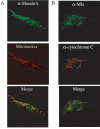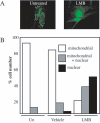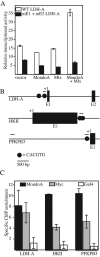MondoA-Mlx heterodimers are candidate sensors of cellular energy status: mitochondrial localization and direct regulation of glycolysis
- PMID: 16782875
- PMCID: PMC1489152
- DOI: 10.1128/MCB.00657-05
MondoA-Mlx heterodimers are candidate sensors of cellular energy status: mitochondrial localization and direct regulation of glycolysis
Abstract
Transcription factors can be sequestered at specific organelles and translocate to the nucleus in response to changes in organellar homeostasis. MondoA is a basic helix-loop-helix leucine zipper transcriptional activator similar to Myc in function. However, unlike Myc, MondoA and its binding partner Mlx localize to the cytoplasm, suggesting tight regulation of their nuclear function. We show here that endogenous MondoA and Mlx associate with mitochondria in primary skeletal muscle cells and erythroblast K562 cells. Interaction between MondoA and the mitochondria is salt and protease sensitive, demonstrating that it associates with the outer mitochondrial membrane by binding a protein partner. Further, endogenous MondoA shuttles between the mitochondria and the nucleus, suggesting that it communicates between these two organelles. When nuclear, MondoA activates transcription of a broad spectrum of metabolic genes, including those for the glycolytic enzymes lactate dehydrogenase A, hexokinase II, and 6-phosphofructo-2-kinase/fructose-2,6-bisphosphatase 3. Regulation of these three targets is mediated by direct interaction with CACGTG sites in their promoters. Consistent with its regulation of glycolytic targets, MondoA is both necessary and sufficient for glycolysis. We propose that MondoA communicates information about the intracellular energy state between the mitochondria and the nucleus, resulting in transcriptional activation of glycolytic target genes.
Figures







Similar articles
-
Glucose sensing by MondoA:Mlx complexes: a role for hexokinases and direct regulation of thioredoxin-interacting protein expression.Proc Natl Acad Sci U S A. 2008 May 13;105(19):6912-7. doi: 10.1073/pnas.0712199105. Epub 2008 May 5. Proc Natl Acad Sci U S A. 2008. PMID: 18458340 Free PMC article.
-
MondoA, a novel basic helix-loop-helix-leucine zipper transcriptional activator that constitutes a positive branch of a max-like network.Mol Cell Biol. 2000 Dec;20(23):8845-54. doi: 10.1128/MCB.20.23.8845-8854.2000. Mol Cell Biol. 2000. PMID: 11073985 Free PMC article.
-
A novel heterodimerization domain, CRM1, and 14-3-3 control subcellular localization of the MondoA-Mlx heterocomplex.Mol Cell Biol. 2002 Dec;22(24):8514-26. doi: 10.1128/MCB.22.24.8514-8526.2002. Mol Cell Biol. 2002. PMID: 12446771 Free PMC article.
-
Glucose sensing by ChREBP/MondoA-Mlx transcription factors.Semin Cell Dev Biol. 2012 Aug;23(6):640-7. doi: 10.1016/j.semcdb.2012.02.007. Epub 2012 Mar 3. Semin Cell Dev Biol. 2012. PMID: 22406740 Review.
-
Interactions between Myc and MondoA transcription factors in metabolism and tumourigenesis.Br J Cancer. 2015 Dec 1;113(11):1529-33. doi: 10.1038/bjc.2015.360. Epub 2015 Oct 15. Br J Cancer. 2015. PMID: 26469830 Free PMC article. Review.
Cited by
-
Protein synthesis inhibitors stimulate MondoA transcriptional activity by driving an accumulation of glucose 6-phosphate.Cancer Metab. 2020 Dec 4;8(1):27. doi: 10.1186/s40170-020-00233-6. Cancer Metab. 2020. PMID: 33292639 Free PMC article.
-
Glucose controls nuclear accumulation, promoter binding, and transcriptional activity of the MondoA-Mlx heterodimer.Mol Cell Biol. 2010 Jun;30(12):2887-95. doi: 10.1128/MCB.01613-09. Epub 2010 Apr 12. Mol Cell Biol. 2010. PMID: 20385767 Free PMC article.
-
Coordination of nutrient availability and utilization by MAX- and MLX-centered transcription networks.Cold Spring Harb Perspect Med. 2013 Sep 1;3(9):a014258. doi: 10.1101/cshperspect.a014258. Cold Spring Harb Perspect Med. 2013. PMID: 24003245 Free PMC article. Review.
-
Glucose-6-Phosphate Upregulates Txnip Expression by Interacting With MondoA.Front Mol Biosci. 2020 Jan 9;6:147. doi: 10.3389/fmolb.2019.00147. eCollection 2019. Front Mol Biosci. 2020. PMID: 31993438 Free PMC article.
-
Metabolic Pathways of the Warburg Effect in Health and Disease: Perspectives of Choice, Chain or Chance.Int J Mol Sci. 2017 Dec 19;18(12):2755. doi: 10.3390/ijms18122755. Int J Mol Sci. 2017. PMID: 29257069 Free PMC article. Review.
References
-
- Altomare, D. A., and J. R. Testa. 2005. Perturbations of the AKT signaling pathway in human cancer. Oncogene 24:7455-7464. - PubMed
-
- Atsumi, T., J. Chesney, C. Metz, L. Leng, S. Donnelly, Z. Makita, R. Mitchell, and R. Bucala. 2002. High expression of inducible 6-phosphofructo-2-kinase/fructose-2,6-bisphosphatase (iPFK-2; PFKFB3) in human cancers. Cancer Res. 62:5881-5887. - PubMed
-
- Baron, A., T. Migita, D. Tang, and M. Loda. 2004. Fatty acid synthase: a metabolic oncogene in prostate cancer? J. Cell. Biochem. 91:47-53. - PubMed
-
- Billin, A. N., and D. E. Ayer. 2006. The Mlx network: evidence for a parallel Max-like transcriptional network that regulates energy metabolism, p. 255-278. In R. N. Eisenman (ed.), The Myc/Max/Mad transcription factor network, vol. 302. Springer, Heidelberg, Germany. - PubMed
Publication types
MeSH terms
Substances
Grants and funding
LinkOut - more resources
Full Text Sources
Molecular Biology Databases
